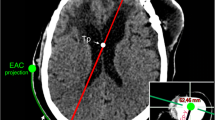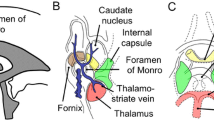Abstract
Introduction
The accurate placement of the ventricular catheter (VC) is critical in reducing the incidence of proximal failure of ventriculoperitoneal shunts (VPSs). The standard freehand technique is based on validated external anatomical landmarks but remains associated with a relatively high rate of VC malposition. Already proposed alternative methods have all their specific limitations. Herein, we evaluate the accuracy of our adapted freehand technique based on an individualized radio-anatomical approach. Reproducing the preoperative imaging on the patient’s head using common anatomical landmarks allows to define stereotactic VC coordinates to be followed at surgery.
Material and methods
Fifty-five consecutive patients treated with 56 VPS between 11/2005 and 02/2020 fulfilled the inclusion criteria of this retrospective study. Burr hole coordinates, VC trajectory, and length were determined in all cases on preoperative computed tomography (CT) scan and were accurately reported on patients’ head. The primary endpoint was to evaluate VC placement accuracy. The secondary endpoint was to evaluate the rate and nature of postoperative VC-related complications.
Results
Our new technique was applicable in all patients and no VC-related complications were observed. Postoperative imaging showed VC optimally placed in 85.7% and sub-optimally placed in 14.3% of cases. In all procedures, all the holes on the VC tip were found in the ventricular system.
Conclusions
This simple individualized technique improves the freehand VC placement in VPS surgery, making its accuracy comparable to that of more sophisticated and expensive techniques. Further randomized controlled studies are required to compare our results with those of the other available techniques.




Similar content being viewed by others
References
Azeem SS, Origitano TC (2007) Ventricular catheter placement with a frameless neuronavigational system: a 1-year experience. Neurosurgery 60(4 suppl 2):243–247
Dias MS, Albright AL (1989) Management of hydrocephalus complicating childhood posterior fossa tumors. Pediatr Neurosci 15(6):283–289
Garell PC, Mirsky R, Noh MD, Loftus CM, Hitchon PW, Grady MS, Dacey RG, Howard MA (2009) Posterior ventricular catheter burr-hole localizer. J Neurosurg 89(1):157–160
Hayhurst C, Beems T, Jenkinson MD, Byrne P, Clark S, Kandasamy J, Goodden J, Nandoe Tewarie RDS, Mallucci CL (2010) Effect of electromagnetic-navigated shunt placement on failure rates: a prospective multicenter study-clinical article. J Neurosurg 113(6):1273–1278
Hayhurst C, Byrne P, Eldridge PR, Mallucci CL (2009) Application of electromagnetic technology to neuronavigation: a revolution in image-guided neurosurgery: technical note. J Neurosurg 111(6):1179–1184
Howard MA, Srinivasan J, Bevering CG, Winn HR, Grady MS (1995) A guide to placement of parietooccipital ventricular catheters. Technical note. J Neurosurg 82(2):300–304
Jakola AS, Reinertsen I, Selbekk T, Solheim O, Lindseth F, Gulati S, Unsgård G (2014) Three-dimensional ultrasound-guided placement of ventricular catheters. World Neurosurg 82(3–4):5–9
Khan NR, DeCuypere M, Vaughn BN, Klimo P (2019) Image guidance for ventricular shunt surgery: an analysis of ventricular size and proximal revision rates. Clin Neurosurg 84(3):624–635
Kim YB, Lee JW, Lee KS, Lee KC (2006) Image-guided placement of ventricular shunt catheter. J Clin Neurosci 13(1):50–54
Levitt MR, O’Neill BR, Ishak GE, Khanna PC, Temkin NR, Ellenbogen RG, Ojemann JG, Browd SR (2012) Image-guided cerebrospinal fluid shunting in children: catheter accuracy and shunt survival: clinical article. J Neurosurg Pediatr 10(2):112–117
Lind CRP, Tsai AMC, Lind CJ, Law AJJ (2009) Ventricular catheter placement accuracy in non-stereotactic shunt surgery for hydrocephalus. J Clin Neurosci 16(7):918–920
Lollis SS, Roberts DW (2008) Robotic catheter ventriculostomy: feasibility, efficacy, and implications. J Neurosurg 108(2):269–274
Merkler AE, Ch’ang J, Parker WE, Murthy SB, Kamel H (2017) The rate of complications after ventriculoperitoneal shunt surgery. World Neurosurg 98:654–658
Pang D, Grabb PA (1994) Accurate placement of coronal ventricular catheter using stereotactic coordinate-guided free-hand passage. Technical note. J Neurosurg 80(4):750–755
Roth J, Constantini S (2012) Selective use of intra-catheter endoscopic-assisted ventricular catheter placement: indications and outcome. Childs Nerv Syst 28(8):1163–1169
Stieglitz LH, Giordano M, Samii M, Luedemann WO (2010) A new tool for frameless stereotactic placement of ventricular catheters. Neurosurgery 67(3 Suppl Operative):131–135
Theodosopoulos PV, Abosch A, McDermott MW (2001) Intraoperative fiber-optic endoscopy for ventricular catheter insertion. Can J Neurol Sci 28(1):56–60
Thomale UW, Knitter T, Schaumann A, Ahmadi SA, Ziegler P, Schulz M, Miethke C (2013) Smartphone-assisted guide for the placement of ventricular catheters. Childs Nerv Syst 29(1):131–139
Thomale U-W, Schaumann A, Stockhammer F, Giese H, Schuster D, Kästner S, Ahmadi A-S, Polemikos M, Bock H-C, Gölz L, Lemcke J, Hermann H, Schuhmann M-U, Beez T, Fritsch M, Orakcioglu B, Vajkoczy P, Rohde V, Bohner G (2016) The GAVCA study-effect of a mobile health application to assist ventricular catheter guidance in a randomized, prospective multicenter trial. Childs Nerv Syst 83(2):252–262
Wan KR, Toy JA, Wolfe R, Danks A (2011) Factors affecting the accuracy of ventricular catheter placement. J Clin Neurosci 18(4):485–488
Wang C, Du H-g, Yin L-c, He M, Zhang G-j, Tian Y, Hao B-l (2013) Analysis of related factors affecting prognosis of shunt surgery in patients with secondary normal pressure hydrocephalus. Chin J Traumatol 16(4):221–224
Whitehead WE, Jea A, Vachhrajani S, Kulkarni AV, Drake JM (2007) Accurate placement of cerebrospinal fluid shunt ventricular catheters with real-time ultrasound guidance in older children without patent fontanelles: technical note. J Neurosurg 107(5 Suppl):406–410
Wilson TJ, Stetler WR, Al-Holou WN, Sullivan SE (2013) Comparison of the accuracy of ventricular catheter placement using freehand placement, ultrasonic guidance, and stereotactic neuronavigation: clinical article. J Neurosurg 119(1):66–70
Author information
Authors and Affiliations
Corresponding author
Ethics declarations
Conflict of interest
The authors declare that they have no conflict of interest.
Ethical approval
The authors confirm that the study was approved by the institutional ethics committee of Erasme Hospital and certify that the study was performed in accordance with the ethical standards as laid down in the 1964 Declaration of Helsinki and its later amendments or comparable ethical standards.
Informed consent
According to ethic committee agreement, patient’s informed consent was deemed not necessary given the retrospective nature of the study.
Additional information
Comments
Optimal placement of ventricular catheters lowers the risk of shunt dysfunction and surgical techniques to improve accuracy of the implantation procedure are therefore interesting for clinicians treating patients with hydrocephalus. In recent years, focus has been centered on neuro-navigation or ultrasound guidance, which has disadvantages and might not be available in all centers. In this single-center study, the authors present a technique involving patient-specific radio-anatomical landmarks (available on standard radiological investigations) to guide free-hand insertion of the ventricular catheter via a parietal approach. In their series of 55 patients using the technique, no catheters were placed in the brain parenchyma and 86% were optimally places inside the ventricular system. The results need to by other groups, but the technique seems simple and straight-forward and might supplement other available measures to improve accuracy of ventricular catheter placement.
Alexander Lilja-Cyron
Copenhagen, Denmark
Publisher’s note
Springer Nature remains neutral with regard to jurisdictional claims in published maps and institutional affiliations.
Julien Spitaels and Matteo Riva co-first Authors
This article is part of the Topical Collection on CSF Circulation
Rights and permissions
About this article
Cite this article
Spitaels, J., Riva, M., Delpierre, I. et al. Freehand stereotactic ventricular catheter insertion for ventriculoperitoneal shunts based on individualized radio-anatomical landmarks. Acta Neurochir 163, 1103–1112 (2021). https://doi.org/10.1007/s00701-020-04702-1
Received:
Accepted:
Published:
Issue Date:
DOI: https://doi.org/10.1007/s00701-020-04702-1




